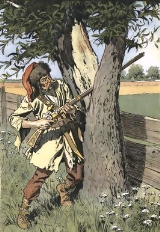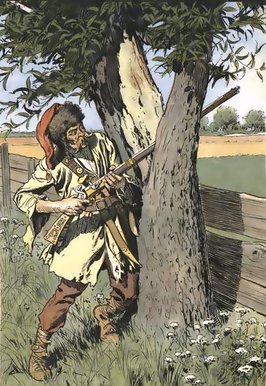
Pandurs
Encyclopedia

Croatia
Croatia , officially the Republic of Croatia , is a unitary democratic parliamentary republic in Europe at the crossroads of the Mitteleuropa, the Balkans, and the Mediterranean. Its capital and largest city is Zagreb. The country is divided into 20 counties and the city of Zagreb. Croatia covers ...
n Austrian
Habsburg Monarchy
The Habsburg Monarchy covered the territories ruled by the junior Austrian branch of the House of Habsburg , and then by the successor House of Habsburg-Lorraine , between 1526 and 1867/1918. The Imperial capital was Vienna, except from 1583 to 1611, when it was moved to Prague...
frontier soldiers, who inhabited the areas of the Kingdom of Croatia (Habsburg)
Kingdom of Croatia (Habsburg)
The Kingdom of Croatia was an administrative division that existed between 1527 and 1868 within the Habsburg Monarchy . The Kingdom was a part of the Lands of the Crown of St. Stephen, but was subject to direct Imperial Austrian rule for significant periods of time, including its final years...
and Military Frontier
Military Frontier
The Military Frontier was a borderland of Habsburg Austria and later the Austro-Hungarian Monarchy, which acted as the cordon sanitaire against incursions from the Ottoman Empire...
, and fought not only in the East
East
East is a noun, adjective, or adverb indicating direction or geography.East is one of the four cardinal directions or compass points. It is the opposite of west and is perpendicular to north and south.By convention, the right side of a map is east....
-Turkish
Ottoman Empire
The Ottoman EmpireIt was usually referred to as the "Ottoman Empire", the "Turkish Empire", the "Ottoman Caliphate" or more commonly "Turkey" by its contemporaries...
front, but also in the West
West
West is a noun, adjective, or adverb indicating direction or geography.West is one of the four cardinal directions or compass points. It is the opposite of east and is perpendicular to north and south.By convention, the left side of a map is west....
-Europe
Europe
Europe is, by convention, one of the world's seven continents. Comprising the westernmost peninsula of Eurasia, Europe is generally 'divided' from Asia to its east by the watershed divides of the Ural and Caucasus Mountains, the Ural River, the Caspian and Black Seas, and the waterways connecting...
an front. They were a non-linear (irregular
Irregular military
Irregular military refers to any non-standard military. Being defined by exclusion, there is significant variance in what comes under the term. It can refer to the type of military organization, or to the type of tactics used....
) army, made out mainly of Croats
Croats
Croats are a South Slavic ethnic group mostly living in Croatia, Bosnia and Herzegovina and nearby countries. There are around 4 million Croats living inside Croatia and up to 4.5 million throughout the rest of the world. Responding to political, social and economic pressure, many Croats have...
. The Pandurs were deployed primarily to raid behind enemy lines, attack baggage and supply trains, conduct guerrilla warfare
Guerrilla warfare
Guerrilla warfare is a form of irregular warfare and refers to conflicts in which a small group of combatants including, but not limited to, armed civilians use military tactics, such as ambushes, sabotage, raids, the element of surprise, and extraordinary mobility to harass a larger and...
, and to fight in extended formations. Apart from Catholic
Catholic
The word catholic comes from the Greek phrase , meaning "on the whole," "according to the whole" or "in general", and is a combination of the Greek words meaning "about" and meaning "whole"...
Croats, there were also some Orthodox Serbs
Serbs
The Serbs are a South Slavic ethnic group of the Balkans and southern Central Europe. Serbs are located mainly in Serbia, Montenegro and Bosnia and Herzegovina, and form a sizable minority in Croatia, the Republic of Macedonia and Slovenia. Likewise, Serbs are an officially recognized minority in...
in Pandurs lines, mainly from Croatian Military Frontier and Slavonian Military Frontier. The Pandurs were formed in the Habsburg Monarchy in the 18th century, but were not deployed in large-scale conflicts (due to their specialized nature). This unit was first mustered by Baron Franz von der Trenck, who served under Maria Theresa of Austria
Maria Theresa of Austria
Maria Theresa Walburga Amalia Christina was the only female ruler of the Habsburg dominions and the last of the House of Habsburg. She was the sovereign of Austria, Hungary, Croatia, Bohemia, Mantua, Milan, Lodomeria and Galicia, the Austrian Netherlands and Parma...
.
Background
In 1740. Austria found itself in the War of the Austrian SuccessionWar of the Austrian Succession
The War of the Austrian Succession – including King George's War in North America, the Anglo-Spanish War of Jenkins' Ear, and two of the three Silesian wars – involved most of the powers of Europe over the question of Maria Theresa's succession to the realms of the House of Habsburg.The...
against the King Frederick II of Prussia
Frederick II of Prussia
Frederick II was a King in Prussia and a King of Prussia from the Hohenzollern dynasty. In his role as a prince-elector of the Holy Roman Empire, he was also Elector of Brandenburg. He was in personal union the sovereign prince of the Principality of Neuchâtel...
. The war eventually embroiled most of Europe, and Queen Maria Theresa needed the help supplied by Baron Trenk, who offered to equip 1000 soldiers to engage in war for the queen.
Pandurs also existed in other countries - Tudor Vladimirescu
Tudor Vladimirescu
Tudor Vladimirescu was a Wallachian Romanian revolutionary hero, the leader of the Wallachian uprising of 1821 and of the Pandur militia. He is also known as Tudor din Vladimiri or — occasionally — as Domnul Tudor .-Background:Tudor was born in Vladimiri, Gorj County in a family of landed peasants...
(approx. 1780 - 1821), the Romanian revolutionary hero, led an army of Pandurs in the Wallachian uprising of 1821
Wallachian uprising of 1821
The Wallachian uprising of 1821 was an uprising in Wallachia against Ottoman rule which took place during 1821.-Background:...
. They most likely originated in the period of Austrian administration in Oltenia
Oltenia
Oltenia is a historical province and geographical region of Romania, in western Wallachia. It is situated between the Danube, the Southern Carpathians and the Olt river ....
(1716/1718-1739).
Composition
The first formation of Trenk's pandurs numbered about 1030 soldiers and had the following officer positions:- One commander, major (oberstwachtmeister Trenk)
- Two captains (kapetan)
- One overlieutenant (oberleutnant)
- Five lieutenants (leutnant)
- One billet (kvartir)
Equipment and clothing
The standard armament of the pandurs was as follows:- 2 pairs of old-fashioned pistolsHandgunA handgun is a firearm designed to be held and operated by one hand. This characteristic differentiates handguns as a general class of firearms from long guns such as rifles and shotguns ....
- YataganYataganThe yatagan or yataghan is a type of Ottomanknife or short sabre used from the mid-16th to late 19th centuries....
- SabreSabreThe sabre or saber is a kind of backsword that usually has a curved, single-edged blade and a rather large hand guard, covering the knuckles of the hand as well as the thumb and forefinger...
- RifleRifleA rifle is a firearm designed to be fired from the shoulder, with a barrel that has a helical groove or pattern of grooves cut into the barrel walls. The raised areas of the rifling are called "lands," which make contact with the projectile , imparting spin around an axis corresponding to the...
The clothing of the pandurs was very similar to the Turkish military uniform. Turkish influence on the culture of the region was heavy, since the Turks had been driven out of Slavonia
Slavonia
Slavonia is a geographical and historical region in eastern Croatia...
only 30 years before.
Pandur Tactics
- Pandurs were used as irregulars, and specialized in behind-the-lines disruptions. They were well-known for their ferocity in such combat.
- They also tended to plunder before engagements, which caused endless grief to their superior officers.
Modern Impact
- Today the word "pandur" in CroatianCroatian languageCroatian is the collective name for the standard language and dialects spoken by Croats, principally in Croatia, Bosnia and Herzegovina, the Serbian province of Vojvodina and other neighbouring countries...
and other former Yugoslav South-Slavic languages is a derogatory term for a police officer akin the "cop" in English. - There is also an Armoured Fighting VehicleArmoured fighting vehicleAn armoured fighting vehicle is a combat vehicle, protected by strong armour and armed with weapons. AFVs can be wheeled or tracked....
called PandurPandur 8X8 APCThe Pandur II 8x8 is an improved modular all-wheel-drive version of the Pandur 6x6 APC wheeled armoured vehicle. It was developed as a private venture by the Austrian company Steyr-Daimler-Puch Spezialfahrzeuge and is currently in production for the Portuguese Armed Forces...
, which is produced by the AustriaAustriaAustria , officially the Republic of Austria , is a landlocked country of roughly 8.4 million people in Central Europe. It is bordered by the Czech Republic and Germany to the north, Slovakia and Hungary to the east, Slovenia and Italy to the south, and Switzerland and Liechtenstein to the...
n company Steyr-Daimler-Puch Spezialfahrzeug (formerly part of Steyr-Daimler-PuchSteyr-Daimler-PuchSteyr-Daimler-Puch was a large manufacturing conglomerate based in Steyr, Austria, which was broken up in stages between 1987 and 2001. The component parts and operations continued to exist under separate ownership and new names.-History:...
).

